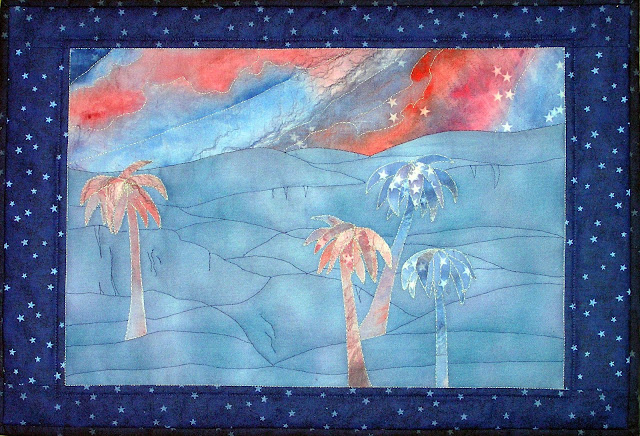Quilt No. 119
June 2017
I live far enough north that bears are a constant source of
conversation. I’ve encountered them
quite frequently. On the edge of the city where I live they’ve come within a few feet
of the front door. They’ve roamed around
our yard with police in tow. They’ve
climbed trees in the yard, refusing to leave until someone got serious with a tranquilizer
gun. (No bears were hurt – but one
wheelbarrow was demolished by a falling bear).
At our cottage bears have graced all parts of the property with their blueberry
spiked droppings, left half-eaten fish on the path, and found and mauled our
food cooler that had been sitting on the deck for less than five minutes. So for these and many more reasons, we think
about bears quite a bit. Of course, we
are not that far north, so all of
these bears are black bears. This is a desirable state of affairs, since
black bears are generally quite easily frightened off. Polar bears?
Not likely to be shooed away by your thrown sneaker.
It seems kind of unfair then that I would do a quilt with
polar bears rather than black bears, but whoever said that life was fair? (Your mother doesn’t count).
The polar bear design that I turned into a small wall quilt
originated at NeedleworksStudio in Cochrane Ontario.
It was designed by Christina Doucette for Row by Row Experience. For the uninitiated, Row by Row Experience
goes on in quilt shops in Canada, the U.S. and Europe. Each shop designs a block that incorporates
the theme for that year. Each one
usually has a local flavor. The blocks are long and narrow, meant to be
sewn together with other “row” blocks.
Add borders, and voila, a full sized quilt emerges. Of course you don’t have to combine rows, you
can stay with just one and use it as a wall hanging or table runner.
Polar bears are perfect for a block that originates in
Cochrane. It isn’t far enough north to
have polar bears dropping by, but it does have a state of the art Polar Bear Habitat. You can even watch them live if you
aren’t lucky enough to be within driving distance.
My husband liked this block when he saw the kit displayed in
the shop. I pretended not to notice that
he was hinting that I buy it. I already
had too many unfinished projects on the go – no time left for bear essentials.
It kind of nagged at me that I hadn’t been more generous and
offered to make if for him. A year later
a friend was down-sizing her stash and gave me the pattern and some fabrics
she’d already picked out for it. Destiny
was looming. The bears were coming for
me.
I went ahead with some of her fabrics and some of my
own. I found a short fiber plush-like
fabric in my drawers of “whites” that was pretty much the most ideal polar bear
fabric in the history of mankind. Clearly
this was karma in its purest form. I
even managed to get the nap of the “fur” going in the right direction. Once you’ve touched one of the polar bears on
the quilt it’s as addicting as stroking a cat.
You will be back for more.
The northern lights proved problematic. I didn’t want to risk pulling in a small
section of the background with the close stitching of “thread painting”.
Without proper planning you will pay for this with ripples somewhere else in
the quilt. I tried some fancy stuff with
organza, but just like everything else I’ve ever tried to do with organza it
was a flop. Actually, I came up with something that looked like a smoky shrub, a
foolish object for an Arctic sky. I finally hit on the idea of using up some of
my precious wool roving (where DO you buy that stuff without having to buy
something the size of a football and the price of a car?). It worked out pretty well until I ran out of
it. I consulted my Weird Wool Drawer and
found one ball that had wool varying in size from skinny strings to fat wool. I stripped out the skinny strings, chopped out
the fat wool parts, and I had some DIY roving.
Best of all, I’d finally used something out of that drawer. It’s a sizable collection of wool oddities
that are almost never useful. I think it’s in cahoots with the organza.
 |
| The Weird Wool Drawer |













